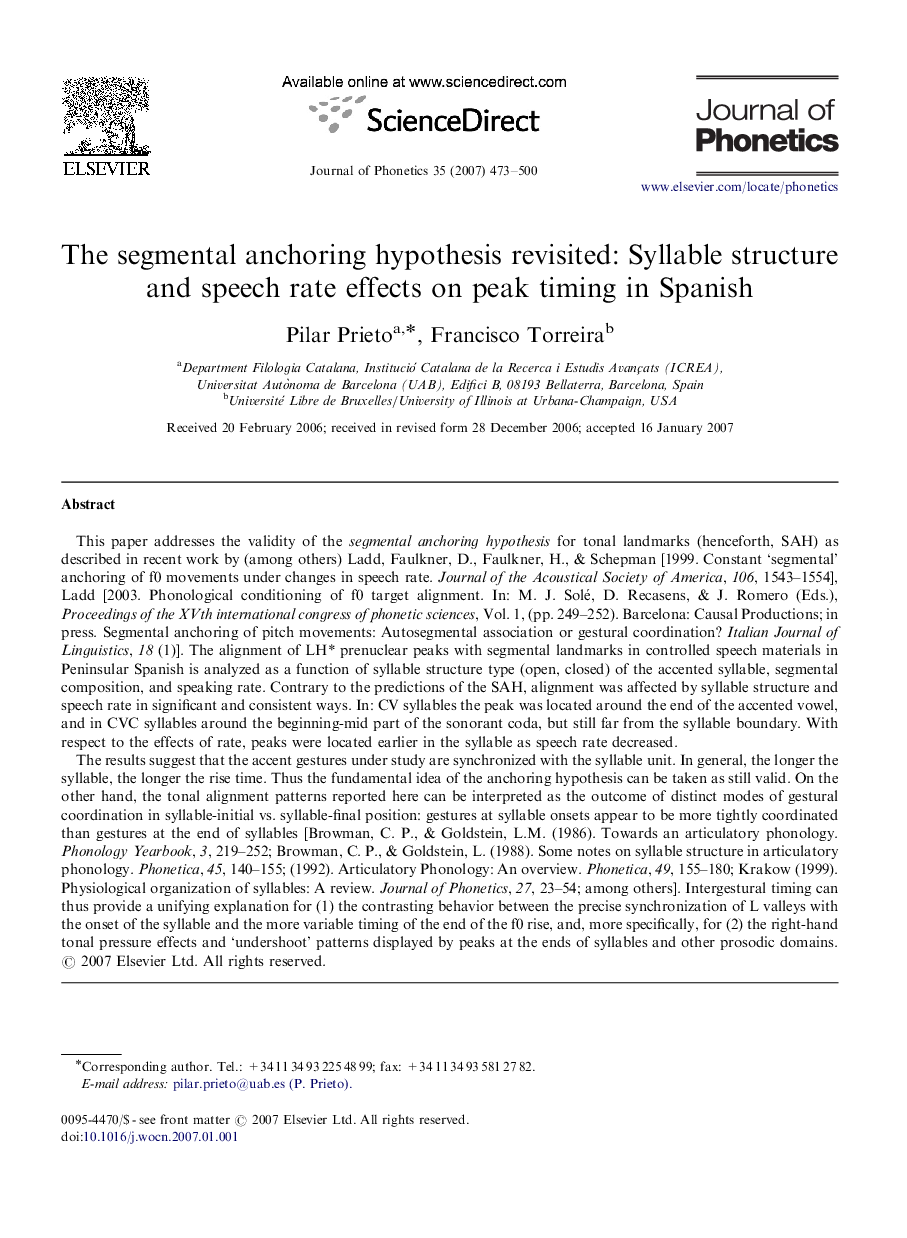| کد مقاله | کد نشریه | سال انتشار | مقاله انگلیسی | نسخه تمام متن |
|---|---|---|---|---|
| 1101184 | 953534 | 2007 | 28 صفحه PDF | دانلود رایگان |

This paper addresses the validity of the segmental anchoring hypothesis for tonal landmarks (henceforth, SAH) as described in recent work by (among others) Ladd, Faulkner, D., Faulkner, H., & Schepman [1999. Constant ‘segmental’ anchoring of f0 movements under changes in speech rate. Journal of the Acoustical Society of America, 106, 1543–1554], Ladd [2003. Phonological conditioning of f0 target alignment. In: M. J. Solé, D. Recasens, & J. Romero (Eds.), Proceedings of the XVth international congress of phonetic sciences, Vol. 1, (pp. 249–252). Barcelona: Causal Productions; in press. Segmental anchoring of pitch movements: Autosegmental association or gestural coordination? Italian Journal of Linguistics, 18 (1)]. The alignment of LH* prenuclear peaks with segmental landmarks in controlled speech materials in Peninsular Spanish is analyzed as a function of syllable structure type (open, closed) of the accented syllable, segmental composition, and speaking rate. Contrary to the predictions of the SAH, alignment was affected by syllable structure and speech rate in significant and consistent ways. In: CV syllables the peak was located around the end of the accented vowel, and in CVC syllables around the beginning-mid part of the sonorant coda, but still far from the syllable boundary. With respect to the effects of rate, peaks were located earlier in the syllable as speech rate decreased.The results suggest that the accent gestures under study are synchronized with the syllable unit. In general, the longer the syllable, the longer the rise time. Thus the fundamental idea of the anchoring hypothesis can be taken as still valid. On the other hand, the tonal alignment patterns reported here can be interpreted as the outcome of distinct modes of gestural coordination in syllable-initial vs. syllable-final position: gestures at syllable onsets appear to be more tightly coordinated than gestures at the end of syllables [Browman, C. P., & Goldstein, L.M. (1986). Towards an articulatory phonology. Phonology Yearbook, 3, 219–252; Browman, C. P., & Goldstein, L. (1988). Some notes on syllable structure in articulatory phonology. Phonetica, 45, 140–155; (1992). Articulatory Phonology: An overview. Phonetica, 49, 155–180; Krakow (1999). Physiological organization of syllables: A review. Journal of Phonetics, 27, 23–54; among others]. Intergestural timing can thus provide a unifying explanation for (1) the contrasting behavior between the precise synchronization of L valleys with the onset of the syllable and the more variable timing of the end of the f0 rise, and, more specifically, for (2) the right-hand tonal pressure effects and ‘undershoot’ patterns displayed by peaks at the ends of syllables and other prosodic domains.
Journal: Journal of Phonetics - Volume 35, Issue 4, October 2007, Pages 473–500